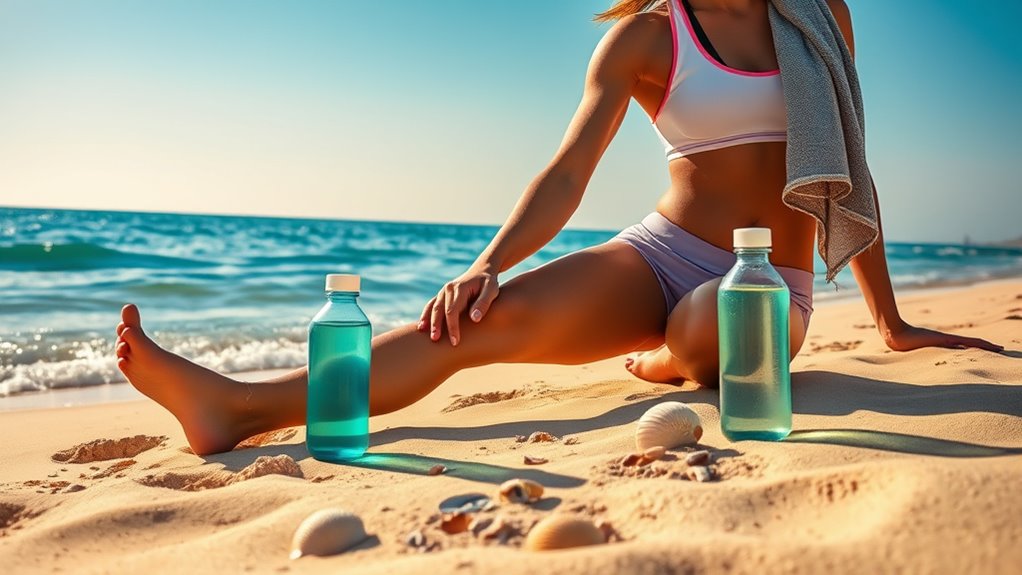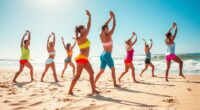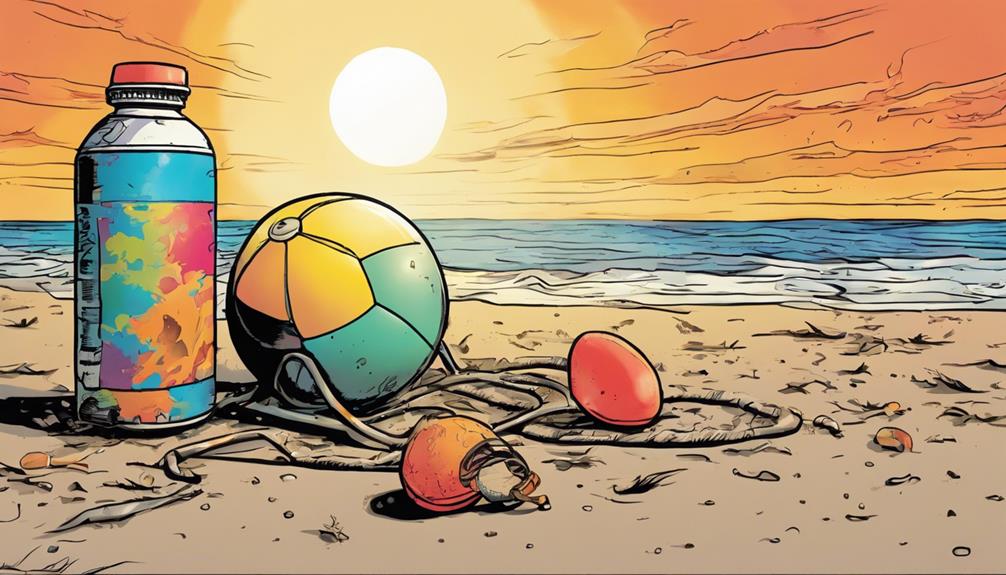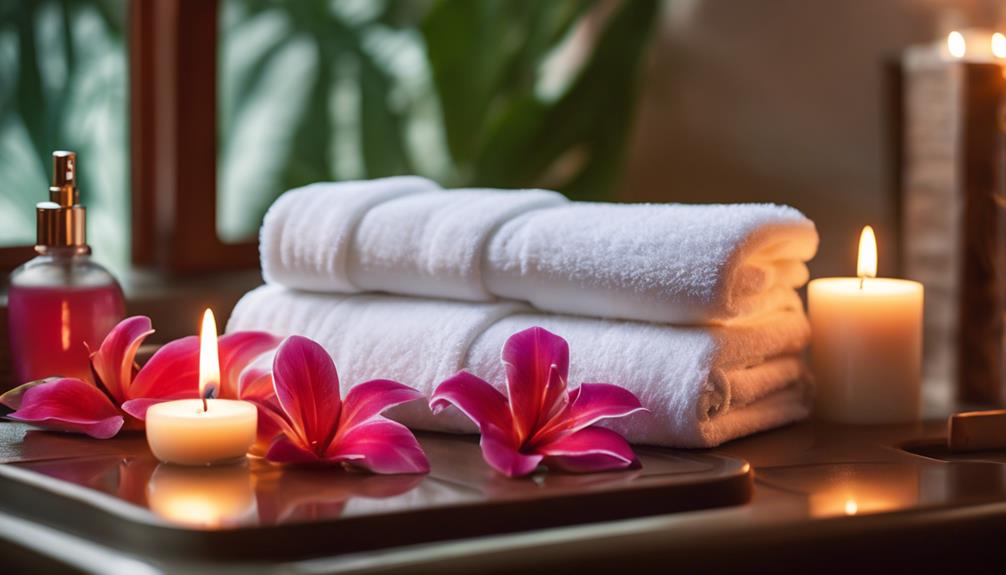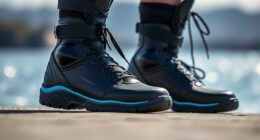After a beach workout, make sure to hydrate thoroughly with water or electrolyte drinks to replace lost fluids. Gently stretch your muscles to reduce stiffness and promote flexibility. Prioritize nutrition by eating protein-rich foods and carbs to support muscle repair. Use cold therapy like ice baths or cold packs to reduce inflammation, and take warm showers or baths to relax muscles. Rest and incorporate active recovery to help your body heal faster—discover more ways to optimize your recovery.
Key Takeaways
- Hydrate immediately with water or electrolyte drinks to restore fluids and minerals lost during beach workouts.
- Perform gentle stretching and foam rolling to alleviate muscle stiffness and improve flexibility.
- Use cold packs or ice baths to reduce inflammation and soreness, especially after intense sessions.
- Consume a balanced meal rich in protein, carbs, and healthy fats within an hour to support muscle repair.
- Prioritize rest and quality sleep to facilitate muscle recovery and prevent overtraining.
Hydrate Thoroughly to Replenish Lost Fluids

After a beach workout, it is essential to rehydrate promptly to replace the fluids lost through sweating and exertion. Drinking water is your best choice; it quickly restores hydration and supports recovery. For intense or prolonged sessions, consider electrolyte drinks to replenish minerals like sodium, potassium, and magnesium that are lost through sweat. Avoid sugary sodas or caffeinated beverages, as they can dehydrate you further. Aim to drink small amounts frequently rather than large gulps at once. If you feel thirsty, that’s a sign you’re already somewhat dehydrated, so drink even more. Proper rehydration helps reduce muscle cramps, prevents dizziness, and promotes faster recovery. Keep water nearby during and after your workout, making hydration a priority in your post-beach exercise routine. Electrolyte balance is also crucial for optimal recovery and preventing muscle fatigue. Recognizing the importance of hydration awareness can further improve your recovery process by ensuring you stay attentive to your body’s signals. Additionally, understanding how the role of color accuracy in projectors affects visual quality can be useful when setting up your home cinema environment for relaxation and entertainment. Maintaining proper hydration levels supports overall performance and endurance during physical activities.
Stretch and Gentle Movement to Alleviate Stiffness

Once you’ve rehydrated, gentle movement and stretching can help ease muscle stiffness caused by your beach workout. Moving your muscles lightly encourages blood flow, which aids in removing lactic acid and reducing soreness. Focus on slow, controlled stretches targeting the muscles you worked most, such as your legs, arms, and core. Avoid bouncing or forcing stretches, as this can cause injury. Incorporate simple movements like arm circles, gentle torso twists, or hamstring stretches. These help loosen tight muscles and restore flexibility. Keep your movements smooth and mindful, listening to your body’s signals. Incorporating proper recovery techniques can further enhance your healing process. Engaging in light activity after your workout can also promote circulation and speed up recovery. Regular, gentle stretching after your workout not only alleviates stiffness but also promotes better recovery and prepares you for your next session. Additionally, understanding muscle recovery methods can optimize the healing process. Incorporating evidence-based practices ensures you follow effective strategies for your recovery. AI-driven solutions are increasingly being integrated into healthcare, optimizing recovery strategies like these.
Prioritize Nutrition to Support Muscle Repair

Proper nutrition plays a pivotal role in supporting muscle repair and recovery after your beach workout. Consuming the right nutrients helps rebuild damaged tissues and replenishes energy stores. Focus on protein-rich foods like lean meats, fish, eggs, or plant-based options to promote muscle synthesis. Carbohydrates replenish glycogen levels, aiding in overall recovery, while healthy fats reduce inflammation. Hydration is also essential; water helps transport nutrients and flush out toxins. To maximize recovery, consider a balanced meal or snack within an hour post-exercise. Here’s a quick guide:
| Nutrients | Food Sources |
|---|---|
| Protein | Chicken, fish, tofu |
| Carbohydrates | Quinoa, sweet potatoes |
| Healthy Fats | Avocado, nuts |
| Hydration | Water, coconut water |
| Vitamins/Minerals | Fruits, leafy greens |
Additionally, understanding the importance of electrical activity in muscle function can help you optimize your recovery and prevent injuries. Recognizing how electric bikes generate power can also inspire ideas for sustainable energy use in your daily activities. Engaging in muscle recovery techniques such as stretching and massage can further enhance your healing process.
Use Cold Therapy and Rest to Reduce Inflammation
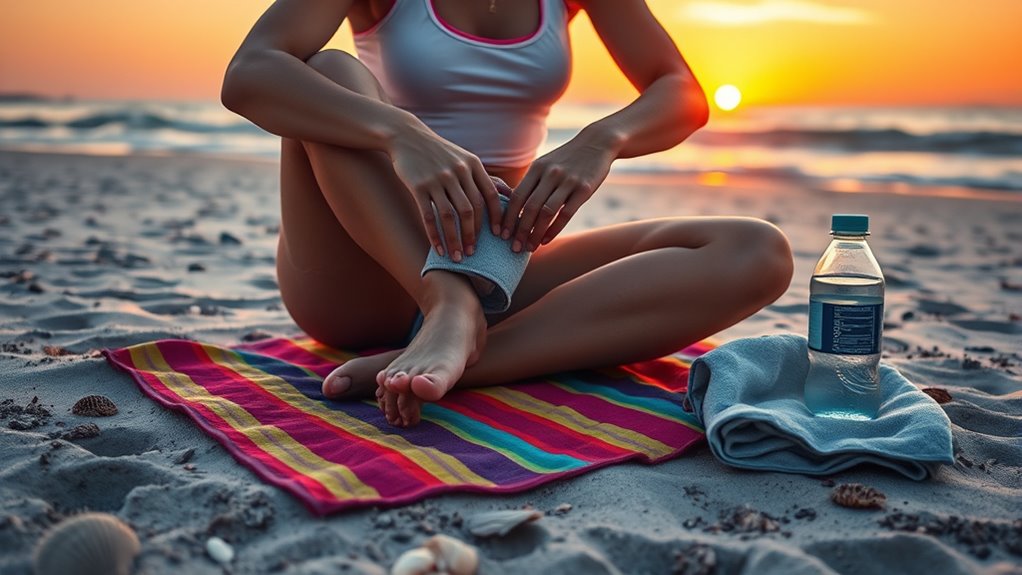
Using cold therapy can help reduce inflammation and soothe your sore muscles after a beach workout. Giving your body adequate rest allows it to recover faster and rebuild muscle tissue. Combining these strategies can get you back on your feet sooner and feeling better. Additionally, employing proper recovery techniques such as gentle stretching and hydration can further enhance your recovery process.
Cold Therapy Benefits
Cold therapy is a highly effective way to reduce inflammation after beach workouts. Applying cold packs or ice baths constricts blood vessels, which helps decrease swelling and numb soreness. This process also slows down cellular activity, reducing tissue damage and inflammation. When you use cold therapy, you’ll notice a faster recovery, allowing you to get back to your routine sooner. It can also diminish muscle pain and stiffness, making movement easier. Additionally, cold therapy may improve your overall recovery experience by decreasing the perception of pain. Regular use after intense beach sessions ensures your muscles and joints stay in better shape, preventing long-term issues. Incorporating cold therapy into your post-workout routine boosts your resilience and keeps you ready for your next workout. Recognizing the importance of staying focused during recovery can help you maintain motivation and consistency in your fitness journey. Using proper recovery techniques can further enhance your healing process and overall results. Engaging in active recovery methods, such as light stretching or walking, can complement cold therapy for optimal healing. Moreover, understanding AI safety principles can help you stay informed about emerging safety measures in health technology. Incorporating evidence-based practices ensures that your recovery methods are both safe and effective.
Rest and Recovery
To effectively reduce inflammation after beach workouts, combining adequate rest with cold therapy accelerates your recovery process. Rest allows your muscles to repair and rebuild, preventing burnout and injury. Prioritize quality sleep and avoid overexertion during the first 48 hours post-workout. Cold therapy, such as ice packs or cold baths, helps constrict blood vessels, reducing swelling and numbing soreness. Use cold treatments for 15-20 minutes at a time, several times a day, especially after intense activity. Listen to your body—if you feel excessive pain or fatigue, take extra rest. Remember, recovery isn’t passive; gentle stretching and hydration further support healing. Incorporating an understanding of angel number soulmates can motivate you to stay positive during recovery and focus on future love opportunities. Understanding the importance of recovery strategies can also enhance your healing process and prevent setbacks. Additionally, maintaining proper nutrition supplies your body with essential nutrients needed for tissue repair and inflammation reduction. Incorporating evidence-based techniques into your recovery routine can optimize results and prevent future injuries. By balancing rest and cold therapy, you’ll minimize inflammation and get back to your beach workouts faster.
Take a Warm Shower or Bath to Relax Muscles

Taking a warm shower or bath can help relax your muscles after a beach workout. The right temperature and timing enhance muscle relief and reduce tension. Keep the water comfortably warm to maximize these benefits without overstimulating your body. Incorporating relaxation techniques like gentle stretches during your bath can further improve muscle recovery.
Muscle Relaxation Benefits
After a vigorous beach workout, a warm shower or bath can work wonders for your muscles. The heat helps increase blood flow, delivering oxygen and nutrients to aid recovery. It also loosens tight muscles, reducing stiffness and soreness. Additionally, the warmth relaxes your nervous system, easing tension throughout your body. To maximize these benefits:
- Use warm water to promote deep muscle relaxation.
- Incorporate gentle massage movements to target specific areas.
- Stay in the water for at least 10-15 minutes to allow full relaxation.
- Add Epsom salts or essential oils to enhance the soothing effect.
Temperature and Timing
A warm shower or bath is one of the most effective ways to relax your muscles after a beach workout. The key is to guarantee the water isn’t too hot, as excessive heat can cause inflammation. Aim for a temperature that’s comfortably warm, around 98-104°F (37-40°C), to promote blood flow and soothe soreness. Timing matters too; don’t rush into it immediately after exercising. Wait about 10-15 minutes to allow your heart rate to normalize and your muscles to cool slightly. This helps prevent dizziness and allows your body to recover gradually. A warm soak for 15-20 minutes can help loosen tight muscles, reduce stiffness, and accelerate your recovery process. Remember, consistency and the right temperature optimize the relaxation benefits.
Incorporate Rest and Recovery Days for Optimal Healing

Incorporating rest and recovery days into your beach workout routine is essential for ideal healing and performance. These days allow your muscles to repair, reduce soreness, and prevent injury. To maximize recovery, consider these strategies:
- Schedule at least 1-2 full rest days each week to avoid overtraining.
- Use active recovery, like gentle walking or stretching, to promote blood flow without straining muscles.
- Prioritize sleep, aiming for 7-9 hours per night, to support tissue repair.
- Incorporate techniques like foam rolling or massages to reduce muscle tightness and enhance circulation.
Frequently Asked Questions
How Soon After a Beach Workout Should I Start My Recovery Routine?
You should start your recovery routine shortly after your beach workout, ideally within 30 minutes. This helps your muscles recover faster and reduces soreness. Immediately hydrate and stretch to loosen tight muscles. If possible, take a cool shower or apply ice to inflamed areas. Prioritize rest and nutritious foods to replenish energy. The sooner you begin, the more effective your recovery will be, ensuring you’re ready for your next activity.
Can Specific Supplements Enhance Recovery After Beach Workouts?
You wonder if specific supplements can boost your recovery after beach workouts. While whole foods like protein and antioxidants are essential, supplements like branched-chain amino acids, omega-3s, and magnesium can support muscle repair and reduce inflammation. Always choose quality products and consult a healthcare professional before adding new supplements to your routine. Incorporating these can help you recover faster, so you can enjoy your next beach adventure feeling refreshed.
What Are Signs of Overtraining or Injury Post-Beach Exercises?
Oh, so you think ignoring pain and pushing through is the secret to greatness? Well, signs of overtraining or injury include persistent soreness, unexplained fatigue, swelling, or sharp pain during movement. If you find yourself constantly exhausted, unable to recover, or experiencing decreased performance, it’s time to listen up. Ignoring these signs risks serious injury, so prioritize rest, proper nutrition, and seek medical advice when needed to stay safe and on track.
Are There Any Beach-Specific Recovery Techniques I Should Consider?
You might wonder about beach-specific recovery techniques, and it’s smart to contemplate them. After a beach workout, prioritize hydration to replenish lost fluids and use cold water immersion or a cool shower to reduce inflammation. Gentle stretching helps loosen tight muscles, while resting in the shade prevents overheating. Think about applying aloe vera or a soothing lotion to any sun-exposed skin. These tailored steps help your body recover quickly and safely.
How Does Beach Sand Impact Muscle Recovery Compared to Gym Workouts?
Ever notice how walking barefoot on beach sand feels oddly soothing? That’s because sand provides gentle resistance, helping your muscles recover by promoting blood flow and reducing soreness. Unlike gym workouts, sand’s uneven surface challenges stabilizer muscles, aiding recovery. Plus, the natural warmth of the sand can relax tight muscles. So, your beach workout doubles as a recovery session, blending exercise and relaxation effortlessly.
Conclusion
Remember, recovery is key to keeping your beach workouts effective and enjoyable. Stay hydrated, stretch gently, and listen to your body. Nourish yourself well and don’t forget to rest—it’s all part of the process. A warm shower or bath can do wonders, too. As the saying goes, “Take time to rest, so you can run faster tomorrow.” Embrace these tips, and you’ll bounce back stronger with each session.

